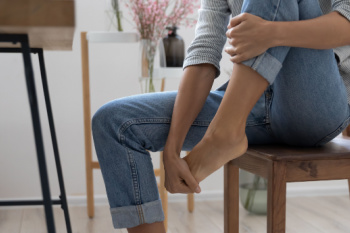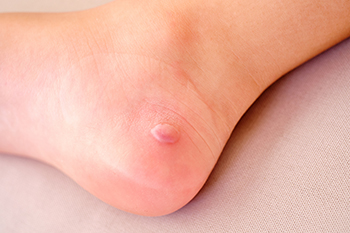Connect With Us
Blog

Pain in the big toe joint, or first metatarsophalangeal joint, may result from a variety of conditions that affect the bones and soft tissue structures of the forefoot. This joint links the long bone of the foot to the base of the big toe and bears significant stress during walking and running. Common causes of pain in the big toe joint include bunions, arthritis, gout, metatarsalgia, and turf toe. A bunion can result when the top of the big toe shifts toward the second toe, causing the bottom of the toe to shift away from the foot. Arthritis, including osteoarthritis and inflammatory types, can damage the joint cartilage, leading to stiffness and pain. Gout, another form of arthritis, may produce sudden swelling due to uric acid crystal deposits in the big toe joint. Turf toe, common in athletes and dancers, may occur from forced upward bending of the toe. A podiatrist can evaluate the underlying cause of your big toe joint pain and may recommend surgery when other methods are not effective. If you have pain in the joint of your big toe, it is suggested that you schedule an appointment with a podiatrist for appropriate treatment.
Toe pain can disrupt your daily activities. If you have any concerns, contact Thomas Bobrowski, DPM of InStride Crystal Coast Podiatry. Our doctor can provide the care you need to keep you pain-free and on your feet.
What Causes Toe Pain?
Most severe toe pain is caused due to a sports injury, trauma from dropping something heavy on the toe, or bumping into something rigid. Other problems can develop over time for various reasons.
Toe pain can be caused by one or more ailments. The most common include:
- Trauma
- Sports injury
- Wearing shoes that are too tight
- Arthritis
- Gout
- Corns and calluses
- Hammertoe
- Bunions
- Blisters
- Ingrown toenails
- Sprains
- Fractures (broken bones)
- Dislocations
When to See a Podiatrist
- Severe pain
- Persistent pain that lasts more than a week
- Signs of infection
- Continued swelling
- Pain that prevents walking
Diagnosis
In many cases the cause of toe pain is obvious, but in others, a podiatrist may want to use more advanced methods to determine the problem. These can range from simple visual inspections and sensation tests to X-rays and MRI scans. Prior medical history, family medical history, and any recent physical traumatic events will all be taken into consideration for a proper diagnosis.
Treatment
Treatments for toe pain and injuries vary and may include shoe inserts, padding, taping, medicines, injections, and in some cases, surgery. If you believe that you have broken a toe, please see a podiatrist as soon as possible.
If you have any questions please feel free to contact our office located in New Bern, NC . We offer the newest diagnostic tools and technology to treat your foot and ankle needs.

Blisters are small fluid-filled pockets that form on the skin due to friction, heat, or irritation. On the feet, they are often caused by wearing tight shoes, prolonged walking or running, moisture buildup, or socks that rub against the skin. Common areas affected include the heels, toes, and soles. Symptoms of a blister include a raised, bubble-like area filled with clear fluid, often accompanied by redness, tenderness, or a burning sensation. Walking can become painful, and, if the blister breaks, it may become vulnerable to infection leading to increased redness, swelling, or pus. While many blisters heal on their own, recurring or infected blisters should be evaluated by a podiatrist. This type of doctor can treat and drain blisters safely, prevent infection, and recommend proper footwear or orthotics to stop future occurrences. They can also identify underlying issues like abnormal gait or foot structure. If you have a painful foot blister, it is suggested that you schedule an appointment with a podiatrist.
Blisters are prone to making everyday activities extremely uncomfortable. If your feet are hurting, contact Thomas Bobrowski, DPM of InStride Crystal Coast Podiatry. Our doctor can provide the care you need to keep you pain-free and on your feet.
Foot Blisters
Foot blisters develop as a result of constantly wearing tight or ill-fitting footwear. This happens due to the constant rubbing from the shoe, which can often lead to pain.
What Are Foot Blisters?
A foot blister is a small fluid-filled pocket that forms on the upper-most layer of the skin. Blisters are filled with clear fluid and can lead to blood drainage or pus if the area becomes infected.
How Do Blisters Form?
Blisters on the feet are often the result of constant friction of skin and material, usually by shoe rubbing. Walking in sandals, boots, or shoes that don’t fit properly for long periods of time can result in a blister. Having consistent foot moisture and humidity can easily lead to blister formation.
Prevention & Treatment
It is important to properly care for the affected area in order to prevent infection and ease the pain. Do not lance the blister and use a Band-Aid to provide pain relief. Also, be sure to keep your feet dry and wear proper fitting shoes. If you see blood or pus in a blister, seek assistance from a podiatrist.
If you have any questions, please feel free to contact our office located in New Bern, NC . We offer the newest diagnostic and treatment technologies for all your foot care needs.

Football places intense stress on the feet and ankles, making injuries in these areas quite common. Sprains, turf toe, fractures, and Achilles tendon issues often happen during quick movements, tackles, or sudden changes in direction. For many athletes, non-surgical treatment is enough. This may include rest, bracing, targeted exercises, and a gradual return to play. Wearing proper footwear and custom orthotics can also help support healing and prevent reinjury. However, when injuries are severe, like torn ligaments or broken bones that do not heal correctly, surgery might be necessary to restore function and stability. Early diagnosis and the right treatment plan can make all the difference in how well and how quickly an athlete recovers. If foot or ankle pain continues after a game or practice, or if there is swelling, bruising, or trouble bearing weight, it is suggested that you see a podiatrist.
Sports related foot and ankle injuries require proper treatment before players can go back to their regular routines. For more information, contact Thomas Bobrowski, DPM of InStride Crystal Coast Podiatry. Our doctor can provide the care you need to keep you pain-free and on your feet.
Sports Related Foot and Ankle Injuries
Foot and ankle injuries are a common occurrence when it comes to athletes of any sport. While many athletes dismiss the initial aches and pains, the truth is that ignoring potential foot and ankle injuries can lead to serious problems. As athletes continue to place pressure and strain the area further, a mild injury can turn into something as serious as a rupture and may lead to a permanent disability. There are many factors that contribute to sports related foot and ankle injuries, which include failure to warm up properly, not providing support or wearing bad footwear. Common injuries and conditions athletes face, including:
- Plantar Fasciitis
- Plantar Fasciosis
- Achilles Tendinitis
- Achilles Tendon Rupture
- Ankle Sprains
Sports related injuries are commonly treated using the RICE method. This includes rest, applying ice to the injured area, compression and elevating the ankle. More serious sprains and injuries may require surgery, which could include arthroscopic and reconstructive surgery. Rehabilitation and therapy may also be required in order to get any recovering athlete to become fully functional again. Any unusual aches and pains an athlete sustains must be evaluated by a licensed, reputable medical professional.
If you have any questions please feel free to contact our office located in New Bern, NC . We offer the newest diagnostic and treatment technologies for all your foot and ankle needs.

